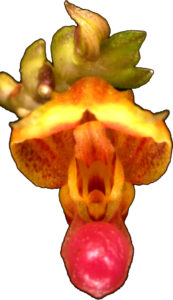 Scaphosepalum orchids can be distinguished from all the other pleurothallid orchids mainly by floral features. In this genus the flowers are not inverted (non-resupinated) and in the majority of the species, the lateral sepals (fused and forming a synsepal) are crowned by two osmophores with the function of secreting fragrances or exudates to attract pollinators. Towards the apex the synsepal and the osmophores contract into the sepaline tails. Both the osmophores and sepaline tails vary greatly in size and shape.
Scaphosepalum orchids can be distinguished from all the other pleurothallid orchids mainly by floral features. In this genus the flowers are not inverted (non-resupinated) and in the majority of the species, the lateral sepals (fused and forming a synsepal) are crowned by two osmophores with the function of secreting fragrances or exudates to attract pollinators. Towards the apex the synsepal and the osmophores contract into the sepaline tails. Both the osmophores and sepaline tails vary greatly in size and shape.
Some species have prominent warts on the floral rachis, and floral with variable shapes. The majority of the species are epiphytes, but several species are terrestrial and can be tall (1.5m) plants.
Why Scaphosepalum?
 Scaphosepalum is a small pleurothallid orchid lineage that encompasses 45 species distributed from Central America to Bolivia. It reaches its diversity peak in the montane habitats of the north central Andes (Ecuador y Colombia). Within Scaphosepalum, there are widespread species and others that are restricted to very small areas of the forest. Many of them are sympatric, in other words, they grow together in the same habitats.
Scaphosepalum is a small pleurothallid orchid lineage that encompasses 45 species distributed from Central America to Bolivia. It reaches its diversity peak in the montane habitats of the north central Andes (Ecuador y Colombia). Within Scaphosepalum, there are widespread species and others that are restricted to very small areas of the forest. Many of them are sympatric, in other words, they grow together in the same habitats.
My research objective is to explore the speciation patterns of the genus and understand which was the role of the Andes in the current distiribution of the species. My goal is to reconstruct the evolutionary history of Scaphosepalumand the final result will be a phylogenetic tree that will explain how are the species related. The phylogenetic tree and spatial distribution (information of the ecosystems) will be integrated and it will hopefully provide clues that will help us understand the speciation patterns of this lineage.
For this project, the phylogenetic trees will be reconstructed using molecular and morphological data, obtaining this information is the longest part of the process of reconstructing the evolutionary history. We hope to share our first discoveries soon!
Check some stories from field trips conducted for this project !
Dr. Barbara Carlsward and her students actively contribute with anatomical research of selected Scaphosepalum species.
Parallel to this project, we are reconstructing the molecular phylogeny of a sister group of Scaphosepalum, Teagueia. The information of these projects (Scaphosepalum and Teagueia) will be of great value to understand why are pleurothallid orchids so diverse, and could probably be common to other lineages of neotropical orchids.
Acknowledgements
This work was and is funded by San Diego County Orchid Society (2001), 13th World Orchid Conference Grant (2005 & 2007),International Association of Plant Taxonomists 2008 ( IAPT – Student Grant ), Peter and Gail Furrniss through the Graduate Student Fellowship of the American Orchid Society (2009), Graduate Student Research Grant (ASPT – 2010). This material is based upon work also supported by the National Science Foundation under Grant No. 1011357. Any opinions, findings, and conclusions or recommendations expressed in this material are those of the author(s) and do not necessarily reflect the views of the National Science Foundation. Many of the plants used in this project are cultivated by the expert hands of the Atlanta Botanical Garden Staff. Ministerio de Ambiente de Ecuador and local governments who provided all the research, collecting and exporting permits.